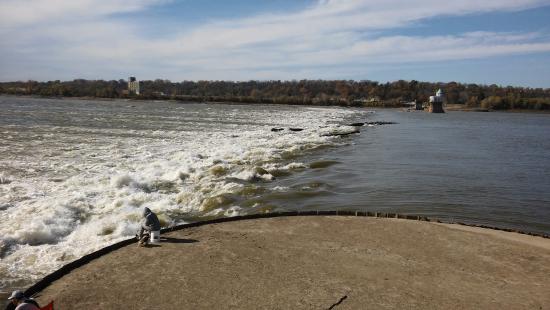Just north of St. Louis, a set of rapids known as the Chain of Rocks stretches across the river. The Chain is no longer entirely natural. A low-head dam also stretches across the river, so paddlers not only face the prospect of rocks in the channel, but pieces of concrete and rebar (and on rare occasions, big pieces of trash like washing machines). Rivers are also dynamic, so conditions can change from one year to the next.
Depending on the river level, paddling through the Chain is either impossible or a breeze. If you’re tempted to bypass the Chain by paddling down the adjacent canal—don’t. The Canal is narrow, there’s no safe place to pull aside if barge traffic is heavy. You should portage around the Chain if the river is too low as this can be an extremely hazardous area. Below you’ll find a few important tips to keep in mind as you approach the rapids.
You’ll always have the option to portage by exiting on the left side of the river (left as you’re facing downstream) just above the fishing access on Chouteau Island (river mile 190.3); look for piles of white rip-rap along the bank. It’s a 200-foot portage, but make sure to put in far enough downriver of the rapids that you don’t get caught in an eddy.
Even if you’re planning on running the Chain, it’s a good idea to get off the river at the portage and take a few minutes to scout out the rapids. From shore, you’ll be able to choose a good path through the rapids and you’ll also be able to spot obstructions that are nearly impossible to see in advance as you’re barreling down the river.
How you approach paddling through (or portaging) will depend on how high the river is. The guidelines below are based on the river height as measured at the St. Louis Gauge.
If the river is below 16 feet on the St. Louis gauge, PORTAGE.
From 16 to 20 feet, your best bet will probably be to stick to the middle of the Chain (stay right of the intake towers) but scout it out first and follow this advice from the Rivergator website:
Use paddler’s common sense and go with the smoothest line of water entering the widest V-line, and keep your eyes open for any last-minute adjustments that might become necessary.
At 20 feet, the best route over the Chain is between the intake towers and over the rapids. At 24 feet and up, most paddlers can safely navigate over the Chain; you may notice only minor turbulence at that river level.
Want more detailed descriptions? Check out Rivergator here and here.
Be forewarned: even after you get through the Chain, dangerous swiftwater conditions await you not far downstream in the St. Louis Harbor around all of the docks, wharves and bridge piers!

The confluence is one of my favorite places, and I paddle there often.
Regarding the two recent accidents at the chain of rocks ( drowning 8 weeks ago, and a recent boat grounding):
I wish there would be HIGH-VISIBILITY signage about 1/4 mile above the confluence on both the Missouri River at RBD, and at RBD on the upper water entry. Hell, a paddler can’t even see the canal signage, as its all the way at LBD.
Take the chain rather than the canal? Really? Go out and look at the boat caught on the rocks. It’s been there a week and will probably turn over. Unless you are on a death wish never go over the chain. You must take the canal!
This advice was meant for paddlers, Randy.
Thanks for the map! It was super helpful on our portage am past the chain of rocks a few days ago. Also a great way to see the river miles. Anyone know of a place where we can see the river miles listed on Google maps for the rest of the river?
Thanks, Robert, for reminding everyone that we are making recommendations for PADDLERS. The canal is a dangerous place for someone in a canoe, kayak, or stand-up paddleboard, which is why we recommend taking the Chain if you’re paddling. But read our recommendations carefully! The Chain is only safe to paddle over at the recommended river levels. When the river is below those levels, paddlers should portage around the Chain.
OK stupid question. By the reference to “paddlers“, is that in reference to somebody who is paddling with a paddle down the river? I only ask, because isn’t that what a canoe and a kayak do? Yet in one of the comments it says the advice is for paddlers not for kayaks and canoes, etc. again, do you not “paddle” a kayak and a canoe? I apologize ahead of time for my ignorance.
Paddlers are someone in a canoe or kayak. The comment that you replied to says, “we recommend taking the Chain if you’re paddling” because, “The canal is a dangerous place for someone in a canoe, kayak, or stand-up paddleboard”. Does this help clear up your confusion?